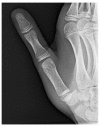Trapeziometacarpal Dislocations in Pediatric Age, Is There a Better Treatment? Series of Cases and a Systematic Review
- PMID: 38673470
- PMCID: PMC11050382
- DOI: 10.3390/jcm13082197
Trapeziometacarpal Dislocations in Pediatric Age, Is There a Better Treatment? Series of Cases and a Systematic Review
Abstract
(1) Background: Dislocations of the trapeziometacarpal joint (TMC) are uncommon in children and adolescents. Only a few isolated cases are reported in the literature. Therapeutic guidance is minimal and inconclusive. (2) Methods: The authors present four patients treated for this unusual lesion. We evaluated the evolution according to treatment, age, patient activity, and quickDASH. Despite the clear limitation of the small number of patients, it is relevant to try to better understand this lesion and its evolution. A systematic review of the literature was also conducted. (3) Results: This is the largest published series of TMC dislocations in children and adolescents. Patients included a 12-year-old girl treated conservatively with a poor quickDASH; a 9-year-old girl treated surgically with the Eaton-Littler technique for a new dislocation with a partially modified quickDASH; a 13-year-old boy with two necessary closed reductions for a new dislocation and a very good final quickDASH; and a 12-year-old boy treated with closed reduction and percutaneous fixation with excellent final results with quickDASH. (4) Conclusions: In the absence of scientific evidence, conservative treatment and ligament reconstruction did not provide good functionality. In contrast, closed reduction with percutaneous fixation provided excellent results. Therefore, the authors would recommend closed reduction and percutaneous needle fixation as an elective method to treat TMC dislocations in pediatric and adolescent patients.
Keywords: adolescent; carpometacarpal joints; cast; child; closed fracture reduction; joint dislocations; recurrence; surgery; surgical; thumb; trapezoid bone.
Conflict of interest statement
The authors declare no conflicts of interest.
Figures








References
Publication types
LinkOut - more resources
Full Text Sources
Miscellaneous

